
On one of my first trips to Europe, I visited Delft, a small town renowned for its art and painting – traditions that have been preserved since well before the 17th Century.

Delft is famous as the birthplace of the talented master painter, Vermeer, and home to the production of the exquisite ‘Delft Blue’ earthenware.
The 2003 movie, The Girl with The Pearl Earring, was set in the town of Delft and based on a novel, of the same name, by Tracy Chevalier. There are reminders everywhere in Delft.
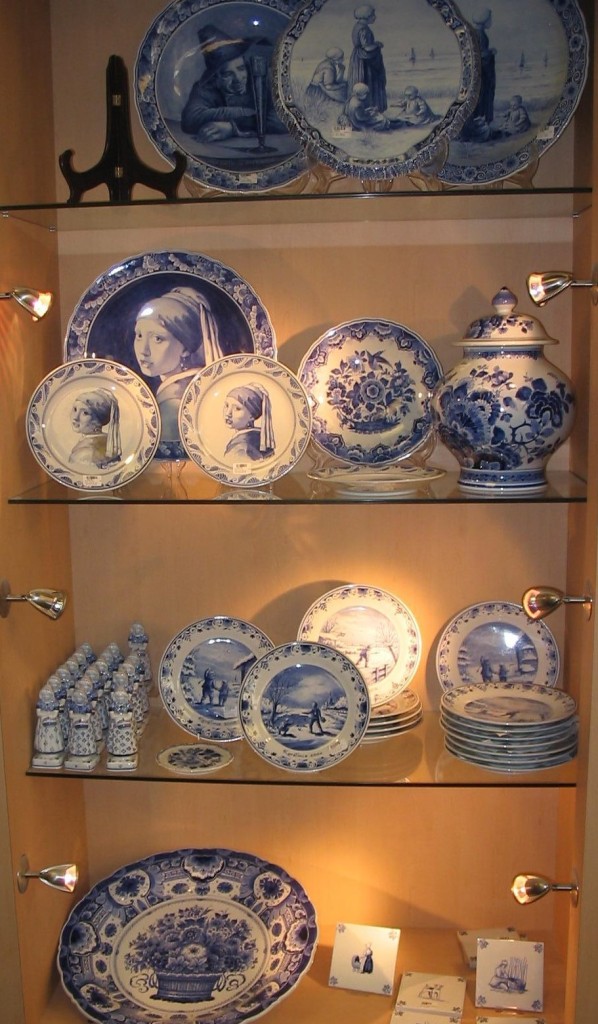
At the Delft factory, the Koninklijke Porceleyne Fles, I took the option of an English-speaking tour. This establishment dates back to 1653, (the Dutch Golden Age). The translations in English were noticeably shorter than the German or Dutch versions, so I can only assume words took longer to say in a different language!
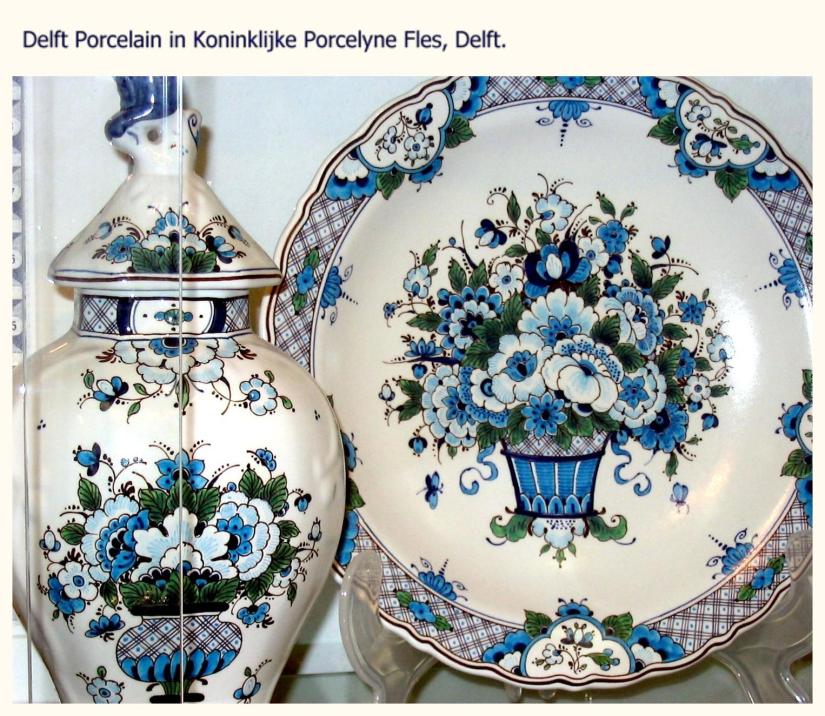
All genuine articles of Delftware have the insignia you see on the header image, on the reverse side of the article. If it is missing, it won’t be a genuine Delft piece, but a cheap imitation – of which there are many.
Not only did I see the production process of a huge variety of magnificent Delft Blue antiques, (even in the ladies toilets where there is a massive mural in painted tiles), but I got to watch the Delft artists at work, painting new earthenware plates and vases.
Painting Delftware
It was interesting to note that prior to painting, the Delft artist traces the designated pattern onto the unfired ?Greenware in carbon, using strategically placed dots, made through holes in the tracing. The designs are then painted with black paint, and the firing process burns off the carbon dots and changes the black paint to the familiar and beautiful Delft blue colour.
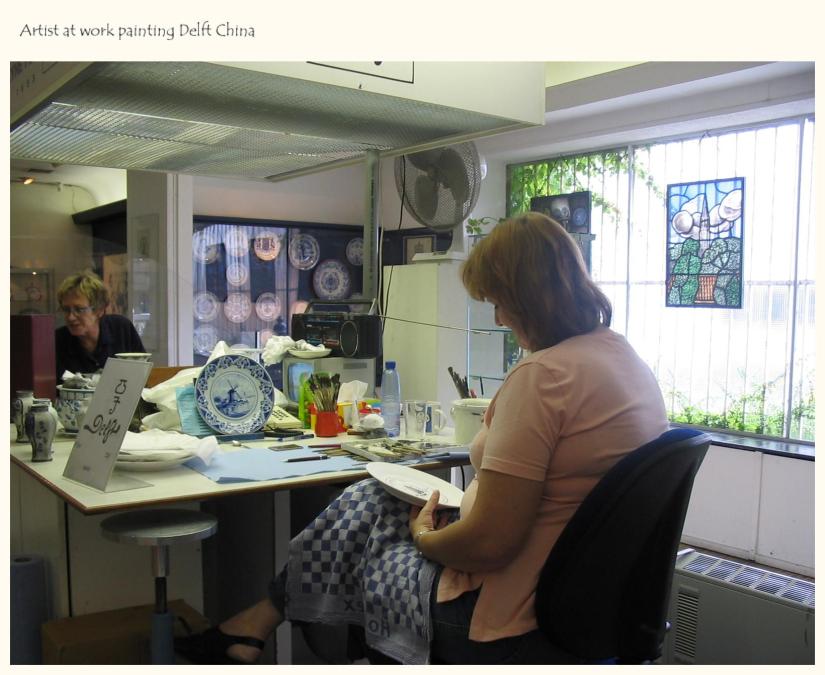
The artists who demonstrate Delft painting, in the public viewing room, only painted for 30 minutes at a time before swapping with other artists, to a private work area. Painting the lines accurately and precisely requires intense concentration. It’s difficult to maintain that level of concentration for any length of time, especially when you have interested tourists gawking at you.
Buying a Piece of Delftware
Heads up: If you’re looking to purchase a genuine Delft hand-painted souvenir, take plenty of money, as it’s very expensive.
There are various colours available too: even green!
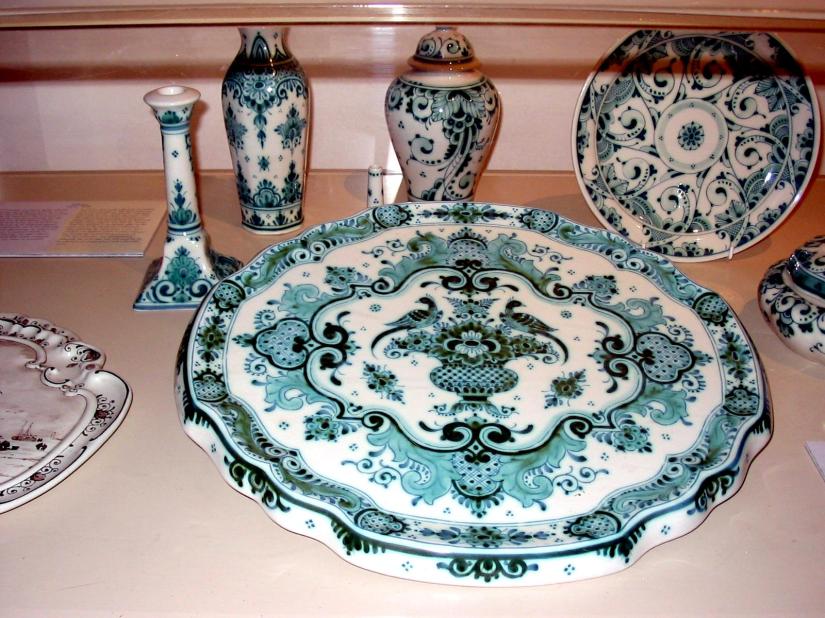
The Netherlands’ vast legacy of decoration, both on earthenware and wooden art is a wonderful inspiration to contemporary artists.
Connections between Traditional Folk Art Styles
It is also noticeable to delve a little further back into history and examine the influences that facilitated the development of the many variants of Dutch folk art.
One rustic folk art style is called Hindelooper and was greatly influenced by the Norwegian decorative painting styles called Rosemaling.
Why?
Dutch Traders borrowed ideas they had seen on their travels and in turn, these new ideas and influences were absorbed back into parochial Dutch culture and art.
One example is the northern provinces of The Netherlands, where Frisian maritime villages traded far more with other Hanseatic trading towns, such as Bergen in Norway than their own countrymen in Amsterdam, resulting in the integration of the Scandinavian dialects and art concepts into their own culture.
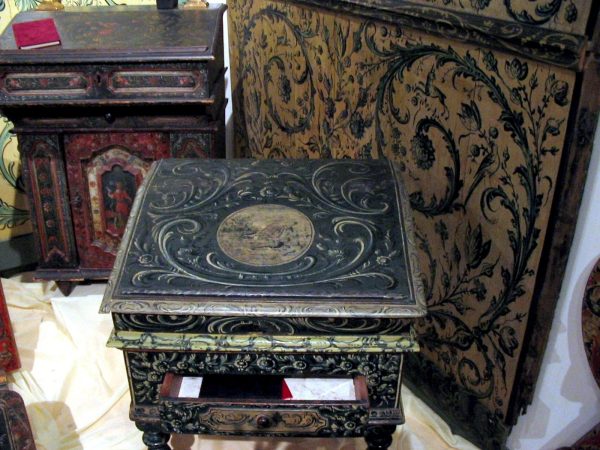



My mother loved Delft—the place and the art. I need to visit.
LikeLiked by 2 people
I am surprised that you have not visited before Peggy – I do hope you get to see it one day. My visit was some time ago so there may have been some changes. The good thing about the old towns in Europe is they just get better they don’t knock them down and rebuild.
LikeLiked by 2 people
We visited Delft in 2006 and I felt in awe of how beautiful the town was. I love places that preserve their traditional arts and promote them too.
My mum was super excited and picked up a few pieces as souvenirs for our home – pieces that are still on display in my folk’s home.
LikeLiked by 2 people
That is fantastic to hear that you appreciate traditional art, Happy Panda. Traditional art is also about society and customs at the time so you get to hear about history too! Did your Mum purchase the blue and white Delft pieces or other items from that delightful place?
LikeLiked by 1 person
The left-hand corner plate in your first photo looks much like the one my parents brought with them when moving to South Africa in 1952. There are three plates. My mother gave me one and my older sister took the other two when my mother passed. My older sister had/has a huge Delft collection. Before moving to NZ I gave my plate to her to go with the other two. The plates are from my grandparents. On one of the old family photos taken in grandparent’s sitting room
You can see one the wall.
LikeLiked by 2 people
Such a beautiful family heirloom for your sister to have. Some people think having blue and white plates on the wall is old-fashioned. I used to display them in my old home and still have one or two about on the wall in the new house. Unfortunately, the new decor doesn’t always blend with traditional artwork. I have taken to using my Royal Copenhagen Christmas plates on a daily basis. I am careful with them and so far none have broken.
How is the move coming along? Settled in?
LikeLiked by 1 person
I’m now in with my son and family since Saturday. Lucky for us yesterday someone put in a bid for the unit. Hopefully everything is now straight sailing to the end and our new farm adventures.
LikeLiked by 1 person
Wonderful news. Full steam ahead!
LikeLiked by 1 person
I thought right away that it looked a bit like your Rosemaling.
Mein gott ! – don’t tell me I’m developing a keen eye at my age !! 😉
LikeLiked by 2 people
You certainly are!
LikeLiked by 1 person
It’s beautiful stuff, isn’t it? Though the process is entirely different it reminds me of our lovely azulejos but, of course, I was aware of Delft porcelain first.
LikeLiked by 2 people
Thanks for mentioning Azulejos, Jo, as it is another art form to research. Is it Portuguese or Spanish in origin?
LikeLiked by 2 people
Origin goes way back to ancient Babylon, Amanda, but variations exist in the Muslim architecture of Spain and simultaneously in Portugal.
LikeLiked by 2 people
I am onto it and will research it thoroughly. Thank you for introducing me.
LikeLiked by 2 people
It’s beautifully decorated and interesting to hear how they incorporated other influences into the patterns. Hopefully it doesn’t die out
LikeLiked by 3 people
I feel like Delft art has a very strong tradition and reputation, but in a minimalist world, there is that possibility of the art form dying out due to economic reasons.
LikeLiked by 1 person
Like many things I suppose which makes things like that all the more precious
LikeLiked by 3 people
This post brought back lovely memories of our day in Delft 40 years ago.
LikeLiked by 3 people
So glad I could trigger nice memories for you. How did you spend that day?
LikeLiked by 1 person
I have a photo of daughter Kate with a painter in the Delft showroom. Maybe I wrote about that day, but I haven’t read the old letter yet.
LikeLiked by 3 people
I look forward to reading that post, Anne.
LikeLiked by 2 people
Delft Blue has always been a favorite, so beautiful!
LikeLiked by 3 people
The distinctive blue and white is timeless art, Dorothy. I have some Royal Copenhagen dishes that are similar in style and I use them every day.
LikeLiked by 2 people
I’ve never been to Delft. It looks lovely and so fascinating to see the artists at work!
LikeLiked by 3 people
It would be so easy for you to visit Delft, Sarah from your location. You have been to the Netherlands before, though?
LikeLiked by 2 people
Oh yes, several times – Amsterdam, Utrecht, Rotterdam (for a football match) and Maastricht
LikeLiked by 3 people
How fortunate- would you believe I have been to many places in The Netherlands but not Amsterdam (apart from Schiphol) and its neighbouring village.
LikeLiked by 2 people
Nice post. It id open. Mysteries of WP. Delft sounds nice. What is weird is we lived 3 years in Holland and never went. My parents could be weird. (We did tour the countryside in obscure towns to go to auctions and buy Dutch painters and furniture, we didn’t go to Den Haag, or Rotterdam or Delft…
Be good.
LikeLiked by 2 people
Those obscure Dutch towns might have been more interesting to you as an adult than as a child. I find them so quaint and fascinating and will write about visiting Hindeloopen a little more in coming weeks.
Why 1972? It reminded me of both a song and a carefree time in my youth. Playing in the street, building cubby houses in the backyard trees,
being free and safe to roam as we wanted. I was 10.
LikeLiked by 2 people
Ten is a wonderful age. Always present in our memories.
Hindeloopen? I am intrigued…
Au revoir.
LikeLiked by 3 people
Hindeloopen is a little maritime village with its own art!
LikeLiked by 2 people
Looked it up. A few pix and on the map. Never been there. Tsss. Have a nice week-end Astrid.
LikeLiked by 3 people
I am not surprised you haven’t visited. It is tiny and it takes a long drive/train to get there. It has to be deliberate and now most of the painting studios are closed. The Museum is fantastic though.
Have a happy and fun weekend too, Brian.
Cheers,
Astrid
LikeLiked by 2 people
🙏🏻
LikeLiked by 2 people
http://www.sohommukherjee.wordpress.com
LikeLiked by 3 people
Delft is lovely….and do you know of the Gouda pottery with its art nouveau styles?
LikeLiked by 2 people
No, Helen. I was not aware that Gouda had a style of Art Nouveau but it is something to research. Can you direct me to any worthy links?
LikeLiked by 2 people
Not ideal, but this will give you an idea.http://www.goudadesign.co.uk/
LikeLiked by 2 people
Lots of inspiration on that site, so thank you Helen. I can definitely see the acanthus motif was used in many of the designs. I will enjoy browsing that site when stuck for inspiration.
LikeLiked by 3 people
Some of these pieces also reminded me of Rosemaling. I’m glad it wasn’t just me.
Absolutely beautiful!
LikeLiked by 3 people
Aha! You have an eye for art, Donna. Did you mean the final photo?
LikeLiked by 1 person
It’s a beautiful craft and what a treat to see it being created in front of you.
LikeLiked by 2 people
It certainly was a treat. The Delft factory is worth a visit, if you are in the region.
LikeLiked by 2 people
There’s green Delft? This is news to me. The effort it takes to make any of it amazes me. We have none, but I think it’s all lovely.
LikeLiked by 2 people
I have only seen the green Delftware is the Delft factory. It was hideously expensive, Ally. I think I do prefer the iconic blue variety, even so.
LikeLiked by 2 people
AWESOME POST FRIEND😊
LikeLiked by 2 people
Thank you Lokesh! Where in the world do you hail from? I am in Australia.
LikeLiked by 1 person
WELCOME FRIEND! I’M FROM SALEM, INDIA AND A DENTIST…
LikeLiked by 3 people
Welcome to Something to Ponder About.
LikeLiked by 1 person
GREAT KNOWING YOU!😊
LikeLiked by 1 person
I wish I’d had the opportunity to go there but I’ll have to make do with a bit of embroidery. I have patterns and made one for a friend already. You know how much I love Rosemaling and also the Blue Delft. I don’t know why the green didn’t resonate well for me. What a sweet town. I get why the artists can only work a short time. Thanks for sharing this.
LikeLiked by 2 people
The green is a bit harder to like. Blue and white is more attractive to the eye. I think it harmonises better with the white background. Green on white is harder to like. Have you posted some of your Delft inspired embroidery? I would love to see that.
LikeLiked by 2 people
Not yet. I gave it away as a gift and will have to see if I took a photo. I plan to do more.
LikeLiked by 3 people
Excellent. You go, girl! 🙂
LikeLiked by 2 people
I specially loved the Vermeer museum. His most famous are not here but in Amsterdam, but they explain his life and painting techniques
LikeLiked by 3 people
I rang out of time to visit the Vermeer museum and would have loved to see it. Have you posted about it at all?
LikeLiked by 1 person
I love Delftware so this was an evocative post. And Delft is a Dutch city I haven’t visited as well.
LikeLiked by 3 people
It surprises me to hear that so many folk who live reasonably close (in relative terms to my distance from Delft) haven’t visited! I imagined it would be quite a popular tourist destination. Perhaps it is someone to plan to visit post Covid, Margaret? Is it easily accessed from your area?
LikeLiked by 2 people
Actually, it was a planned trip for my husband’s Significant Birthday which Covid put a stop to – we were going there and to Dordrecht. To re-arrange…
LikeLiked by 2 people
Oh no. What a shame. Next year maybe?
LikeLiked by 2 people
Let’s hope!
LikeLiked by 3 people
Some beautiful architecture and art🙏🏼
LikeLiked by 1 person
Yes I agree. Have you visited the area?
LikeLiked by 1 person
I have several small souvenirs from Delft, in traditional blue white colours from my friends who visited it. Hopefully, I’ll get to see more of the Netherlands than just Venlo which I visited last year
LikeLiked by 1 person
There really is a lot to see in The Netherlands, Tanja. You are fortunate that it is not so far for you to travel to visit. I hope you do get to see more. Did you fly or take a train/drive to Venlo last year?
LikeLiked by 1 person
We drove on the
LikeLiked by 1 person
We drove there from Germany because it was close to the German airport from which I flew back home
LikeLiked by 2 people
Everything in Europe is close! Compared to my country. Ypu sn just pop over to the neighbouring country for a day or so. Wonderful.
LikeLike
Sorry. I meant:
You can just pop over to the neighbouring country* in the previous comment. Darn phone keyboard is too small or my finger too big!
LikeLike
Hai
LikeLike
Beautiful pictures. I love the buildings
LikeLiked by 1 person
Thank you
LikeLike
You are welcome
LikeLike
hi
LikeLike
Very interesting! I enjoyed reading about this.
LikeLiked by 1 person
Thank you for visiting and taking the time to comment. Have you visited Delft or the Netherlands?
LikeLike